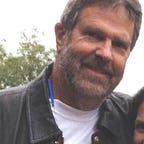City Centers Designed Like Theme parks?
The car is left at the perimeter, you move seamlessly on some tram or conveyor while window shopping or friendly stops at novelty restaurants or attractions…this describes theme parks and airports, why can’t it describe urban city centers?
At the risk of sounding like Andy Rooney on old “60 Minutes” shows, do you ever wonder why the main transit destinations in downtown San Francisco (Ferry Building, Embarcadero Muni/BART, Transbay Terminal, ATT Park/Caltrain) are so far apart? Help is on the way in the form of the pricey Caltrain extension to Transbay Terminal, but ouch! If you’ve ever been in a rainstorm trying to get from the Ferry Building or Transbay to Muni, those few blocks can be a cold, wet dodge through life-threatening traffic trying to catch that last transit leg to work.
Contrast this with the jaunt from the airport to the train station in, let’s say, Frankfurt, Germany, where an underground people mover whisks you a few miles through a mall and before you know it…you’re there, dry and safe. If airports the world over give us the dignity of people movers and conveyors (in addition to baggage and utility vehicles on separate conveyances), then why are urban areas so chaotic? Why are pedestrians/transit riders treated so badly?
Well fear no more, because as you might’ve guessed, I have the solutions:
A) Build an underground tube from the Ferry Building to Muni/BART which can carry SMART trains (coming over on ferries) seamlessly to the Embarcadero Station (You could even run these SMART cars down to Civic Center if you wanted, same gauge). Have a people conveyor in this tube for those wanting to transfer to Muni/BART, with shops along the way. This would travel under Market St.
B) Have this tube continue on to the Transbay Terminal, also with people conveyor/shops, perhaps also with continuing SMART/Muni tracks. This would travel under Main St. At that point, you would have access to the ballpark and entire peninsula via Caltrain (once the Caltrain extension is built). Muni Metro would at last have a Transbay connection, and at worst they would be a short pedestrian conveyor or SMART ride to the Ferry Building while shopping en route (of course it could turn into seedy shopping like Powell St BART tattoo parlors and Second-hand stores but stay with me here!) Actually, this section of pedestrian conveyance has been promised as part of the new Transbay Terminal/Caltrain extension, but this is for pedestrians only and would not include a Muni train or shops.
See how simple? Not a great distance here, about 3,000 ft from Ferry Building to Muni/BART, another 4,000 from there to Transbay, about 1.3 miles, very doable with utilities placed within the underground transit chases (much cleaner, more accessible)
Downtown transit hub solved! Now why not a mezzanine people-mover for the main shopping and convention center in town?
While we’re at it, let’s finish making urban San Francisco seamlessly accessible for pedestrians wanting to continue on to Union Square or Moscone Center without parking, getting wet or mugged. I propose a mezzanine level conveyor system that could be cheaply connected to existing buildings. And don’t say that’s never been done before, because the Las Vegas strip has a mezzanine level conveyor system, as does essentially every airport in the world.
However, ours would run in plexiglass tubes bolted to buildings accessible by stairwells/ADA elevators at selected intersections. There would be ample clearance for vehicles below, plus room in these tubes for utility chases, so as to unclutter the streets below. Mine would run in a loop from Montgomery BART down Post St to Union Square, then down Stockton and 4th St to Moscone, then Howard to near SFMOMA, then back on 2nd St to BART. It would not run down Powell so as to compete with cable car service. There would be entry/exit points at Post/Market, Post/Stockton, Stockton/Market, 4th St/Howard, 3rd St/Howard, and 2nd St/Howard. It would’ve been nice to include the Curran Theater within this loop but heck, it would be only 2 blocks from an exit point and theater goers are usually attending off-peak plus they could likely use the exercise.
The best thing about these additional transit devices is that they could house businesses that would pay rent, or buy space outright, so that the system could eventually pay for itself. Security officers could be paid for collectively by the vendors built into the system, sort of like mall cops.
A possible added side benefit would be to move freight in these tunnels/conveyances after-hours, so as to decrease truck traffic on surface streets during business hours, making it safer for buses, taxis, and cyclists. It goes without saying that the frightening number of SF traffic/pedestrian collisions would be reduced by this effort.
Perhaps someday you would have a chance at that seamless commute to the City, with a pedestrian transfer taking you straight to points of interest without getting wet, robbed, or being a traffic pinball. Maybe taxi drivers and buses would even have a chance at making a right turn without waiting for pedestrians to clear and getting signal gridlocked.
And maybe it could come at a reasonable price to us taxpayers, with merchant buy-in.
Also, enjoy these other Transportation-related articles by Vern Scott!
